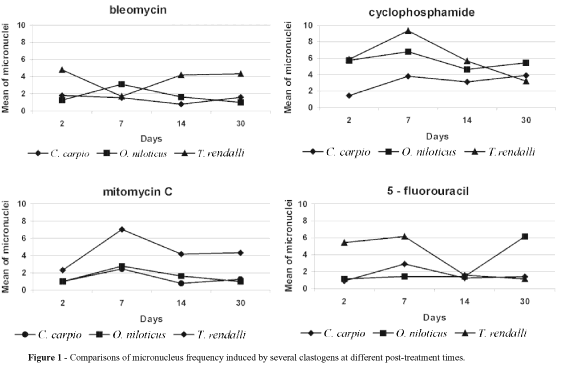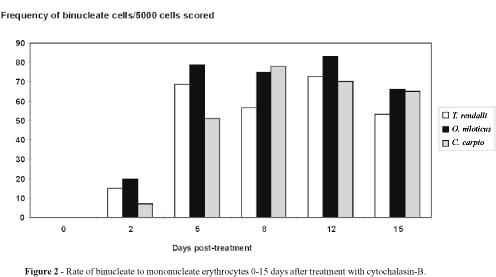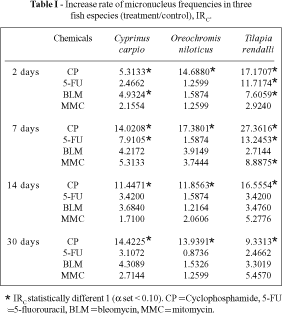Abstracts
Fish are often used for screening genotoxicity of water. For such programs, a knowledge of the sensitivity to clastogens, spontaneous micronucleus frequency and cell cycle kinetics of the target tissue is necessary. To investigate the pattern of inter-specific sensitivity to micronucleus induction three species of fish, Tilapia rendalli, Oreochromis niloticus and Cyprinus carpio, were exposed to the clastogens bleomycin (BLM), cyclophosphamide (CP), 5-fluorouracil (5-FU), and mitomycin C (MMC). The binucleate/mononucleate ratio in peripheral erythrocytes exposed to cytochalasin B was also used to evaluate the time-dependent response of micronucleus formation during hematopoesis in the kidney and the micronucleus peak in peripheral erythrocytes. Micronucleus frequencies induced by CP were significantly greater than their respective controls for the three fish species throughout all treatment periods. During the whole evaluation period (30 days) CP was also the most effective clastogen. In general, until the 14th day of evaluation period T. rendalii was the most sensitive species to clastogens. No difference in micronucleus frequencies among species was observed in the 4th evaluation (at the 30th day). A micronucleus peak was observed at the 7th day after treatment. After the 14th day the frequencies were stabilized. The cytochalasin B experiment was carried out to demonstrate that micronuclei induced in the young kidney erythrocyte cells were detected in the circulating blood 2-4 days later.
Este estudo fez uma avaliação da indução de micronúcleos em eritrócitos de sangue periférico de peixes Tilapia rendalli, Oreochromis niloticus e Cyprinus carpio após o tratamento com mitomicina C, ciclofosfamida, 5-fluorouracil e bleomicina. Foram colhidas amostras periódicas de sangue com 2, 7, 14 e 30 dias após o tratamento único. Os tratamentos com citocalasina B tiveram como objetivo analisar as proporções entre células binucleadas/mononucleadas nos diferentes períodos de tratamento, para a comparação com os picos de micronúcleos entre as diferentes espécies, uma vez que o orgão hematopoiético nos peixes é o rim cefálico e o sangue analisado é de origem periférica, o que nos dá uma noção do tempo do ciclo celular dos eritrócitos. A análise das taxas de aumento das freqüências de micronúcleos ao longo do tempo demonstrou que do 2° ao 7°dias elas foram crescentes, decresceram ao 14° dia e mantiveram-se estáveis até ao 30°. Os 4 compostos químicos aumentaram significativamente as freqüências de micronúcleos ao longo de todo o período de tratamento, sendo que a ciclofosfamida e a mitomicina C foram as mais efetivas. A T. rendalli foi a espécie mais sensível a todos os tratamentos, enquanto que C. carpio foi a mais resistente. Entre 2 e 7 dias pós-tratamento observaram-se as maiores induções de micronúcleos. A partir do 14° dia de tratamento as freqüências de micronúcleos tenderam a diminuir e as diferenças entre as espécies não foram significativas.
VARIABILITY IN MICRONUCLEUS INDUCTION WITH DIFFERENT MUTAGENS APPLIED TO SEVERAL SPECIES OF FISH
Cesar Koppe Grisolia1 and Célia Maria Torres Cordeiro2
1Departamento de Genética e Morfologia, Instituto de Ciências Biológicas, Universidade de Brasília, 70910-900 Brasília, DF, Brasil. Send correspondence to C.K.G. Fax: +55-61-273-4942. E-mail grisolia@unb.br
2Centro Nacional de Pesquisa de Recursos Genéticos e Biotecnologia, Embrapa/Cenargen. SAIN - Parque Rural, 70770-900 Brasília, DF, Brasil. Fax: +55-61-340-3624.
ABSTRACT
Fish are often used for screening genotoxicity of water. For such programs, a knowledge of the sensitivity to clastogens, spontaneous micronucleus frequency and cell cycle kinetics of the target tissue is necessary. To investigate the pattern of inter-specific sensitivity to micronucleus induction three species of fish, Tilapia rendalli, Oreochromis niloticus and Cyprinus carpio, were exposed to the clastogens bleomycin (BLM), cyclophosphamide (CP), 5-fluorouracil (5-FU), and mitomycin C (MMC). The binucleate/mononucleate ratio in peripheral erythrocytes exposed to cytochalasin B was also used to evaluate the time-dependent response of micronucleus formation during hematopoesis in the kidney and the micronucleus peak in peripheral erythrocytes. Micronucleus frequencies induced by CP were significantly greater than their respective controls for the three fish species throughout all treatment periods. During the whole evaluation period (30 days) CP was also the most effective clastogen. In general, until the 14th day of evaluation period T. rendalii was the most sensitive species to clastogens. No difference in micronucleus frequencies among species was observed in the 4th evaluation (at the 30th day). A micronucleus peak was observed at the 7th day after treatment. After the 14th day the frequencies were stabilized. The cytochalasin B experiment was carried out to demonstrate that micronuclei induced in the young kidney erythrocyte cells were detected in the circulating blood 2-4 days later.
INTRODUCTION
A growing interest in genotoxicity caused by environmental pollutants has led to the development of several biological tests for detecting and identifying genotoxicants in the air, water and soil. Fish provide a suitable model for monitoring aquatic genotoxicity and wastewater quality because of their ability to metabolize xenobiotics and accumulate pollutants. A micronucleus assay has been used successfully in several species (De Flora et al., 1993; Al-Sabti and Metcalfe, 1995; Minissi et al., 1996).
Development of a biomonitoring program in fish requires knowledge of the kinetics of the erythrocyte life cycle and of micronucleus induction. The frequency of spontaneous and induced micronucleus formation over time needs to be determined in order to confirm the usefulness of the species for this assay. In bony fishes, the main hemopoietic site is the head kidney; however, erythrocyte micronuclei assays from peripheral blood have been elected by different authors as the main endpoint (Kligerman et al., 1975; Hooftman and De Raat, 1982).
We investigated the intra- and inter-specific sensitivities of three species of fish, Tilapia rendalli, Oreochromis niloticus and Cyprinus carpio, to micronucleus induction following exposure to the clastogens bleomycin (BLM), cyclophosphamide (CP), 5-fluorouracil (5-FU) and mitomycin C (MMC). The kinetics of the erythrocyte cell cycles were also studied in the presence of cytochalasin-B (Cyto-B).
MATERIAL AND METHODS
Fish treatments and micronucleus test
The quality of Lake Paranoá water is continuously monitored by the local water-treatment company, and includes measurement of the levels of oxygen, nitrogen, phosphorus and chlorophyll-a, to evaluate the degree of eutrophication. There are no chemical industries or agricultural fields around the lake, an artificial eutrophic tropical reservoir. Specimens of the three fish species were caught at the same sites and were acclimatized in the laboratory for 10 days in 500-l tanks of dechlorinated tap water aerated continuously at 20 ± 2oC and pH = 7.0. Peripheral blood samples were obtained from the gills and immediately smeared. After drying for 24 h at room temperature, the smears were fixed in methanol for 15 min and stained with Giemsa. Three thousand erythrocytes were examined per fish in coded slides. Control blood samples were obtained before each treatment and 2, 7, 14 and 30 days after a single intra-abdominal injection of the mutagen. The maximum tolerated dose for each species was determined in preliminary experiments. In another series of experiments, blood samples were collected from the same fish at 0, 2, 5, 8, 12 and 15 days after a single injection of cytochalasin B (50 µg/kg body weight, b.w.). For each treatment period, five thousand erythrocytes were scored to determine the binucleate/mononucleate ratio.
Chemicals tested
BLM (12.5 mg/kg b.w.) are glycopeptide antibiotics isolated from Streptomyces verticillus and are routinely used in cancer chemotherapy. These compounds exert their genotoxic effect by causing oxidative damage to DNA, which in turn leads to gene mutations, chromosomal aberrations and aneuploidy (Vig and Lewis, 1978; Povirk and Austin, 1991). CP (Enduxan, 20 mg/kg b.w.) has been widely used as a positive control because of its alkylating activity. CP itself is not genotoxic but undergoes complex metabolic activation by mixed function oxidases which results in genotoxic metabolites (Colvin and Chabner, 1990). 5-FU (Roche, 2.5 mg/kg b.w.), an antineoplastic drug which acts as a pyrimidine antagonist, interferes with pyrimidine-nucleotide synthesis and is incorporated into RNA. 5-FU acts directly or indirectly on enzymes in the early steps of DNA synthesis. At low doses, 5-FU increases the rate of mouse bone marrow micronucleus formation after 24 h, through a mechanism involving metabolic inhibition (Maier and Schmid, 1976). MMC (Bristol, 1 mg/kg b.w.) has DNA cross-linking and alkylating activity, and is water-soluble with a relatively short biological half-life in rats (Kerpel-Fronius et al., 1988). Cyto-B (Sigma, 50 µg/kg b.w.) inhibits cytoplasmic cleavage without preventing mitosis, resulting in binucleated and multinucleated cells. All test compounds were dosed at maximum tolerated dose (MTD), previously determined. At the MTD toxic signals were observed such as feed refuse, scale losses and alteration in the swim behavior and motility.
Statistical analysis
A multivariate ANOVA was used to compare the effects of chemicals and species on micronucleus frequencies over four-treatment periods. Micronucleus frequency at each evaluation period, micronucleus frequency differences between successive evaluation periods and micronucleus frequency differences between treatments and their controls were submitted to univariate analysis of variance to test for the effects of chemicals, species and their interactions. These analyses were carried out using SAS/PROC GLM. Multiple comparisons among means were obtained employing t-adjusted P values (SAS/PROC MULTTEST). A log transformation was applied to micronucleus frequencies before analysis, in order to stabilize the variance. The results were presented in the original scale after transforming them back to frequencies. The back transformed value obtained for differences between successive treatment periods was denominated "increase rate" (IR) - the mean ratio between micronucleus frequency of successive evaluation periods. For the differences between treatments and controls the value obtained for back transformation to original scale was denominated "increase rate control" (IRC),the mean ratio between micronucleus frequency of each treatment and its control.
RESULTS
CP induced the highest IRC values in all treatment periods (Table I). After the 14th day the IRC of all clastogens was stabilized for all the species studied. Spontaneous micronucleus frequencies (controls) among the three species were significantly different (P = 0.038, Table II). Different patterns of micronucleus frequencies were identified for the combinations of clastogens and species throughout the evaluation periods (Pillas's trace criterion, P = 0.0463). There were significant differences among species and chemicals (P < 0.05), except at the 30th day when no significant difference among species was detected (Table II and Figure 1). The multiple comparisons for each evaluation period demonstrated significantly that, in general, CP was more effective as a clastogen than MMC, 5-FU and BLM. Comparing fish species, T. rendalli was the most sensitive, while C. carpio was the most resistant. At the 7th day (second evaluation time), when there was a micronucleus frequency peak, T. rendalli showed a significantly inferior sensitivity to BLM. The peak effect of this drug to T. rendalli occurred during the earlier evaluation period, at the 2nd day after treatment. Another way of analyzing the clastogen behavior for the three species is to examine the IR variation during the successive evaluation periods. The mean IR from 7 to 2 days was 1.64 ± 0.21. MMC had an IR significantly superior to 1 during this interval while BLM remained stable (Table III). The overall IR from 14 to 7 was 0.58 (IC95%: 0.42-0.80), significantly inferior to 1 (P = 0.0005). This indicates a tendency towards decrease of micronucleus frequencies between these later two evaluation periods while the earlier two showed a tendency towards increase. IR in the interval from 14 to 7 did not change significantly with species or clastogens. The overall IR from 30 to 14 days was 0.93, which is not significantly different from 1 (P = 0.6954), and this means that no tendency towards a decrease in micronucleus frequency was detected during this interval.
The time required for the appearance of binucleated erythrocytes in peripheral blood was two days and the maximum binucleate/mononucleate ratio was observed 5-12 days after treatment with Cyto-B. Comparing each period of treatment, the highest increase in binucleate/mononucleate ratio was observed from two up to five days post-treatment with Cyto-B. The time lag in the micronuclei induction and increasing binucleate/mononucleate ratio in peripheral erythrocytes were coincident (Figure 2).
DISCUSSION
Bahari et al. (1994) showed a linear, dose-dependent increase in erythrocyte micronuclei two to four days after g-radiation and mitomycin-C treatment in the catfish Clarias gariepinus. Similarly, Hooftman and De Raat (1982) reported a dose- and time-dependent increase in micronuclei in erythrocytes from the eastern mudminnow Umbra pygmaea treated with ethyl methanesulfonate. Time-dependent responses have also been observed in amphibians exposed to radiation (Siboulet et al., 1984; Fernandez et al., 1993). We demonstrated that related species, such as T. rendalli and O. niloticus, give different responses to genotoxic agents. According to clastogen and the species studied, the frequency of micronuclei may suffer important variations. If the kidney is the main hemopoietic tissue in fish, and if micronuclei are formed during hematopoesis, then the time required for the completion of the mitotic cycle in erythrocytes must previously be estimated. We found that the peak occurrence of micronuclei was correlated with the life cycle of these cells in the kidney. There was a period of latency between treatment and subsequent micronucleus peak in peripheral blood erythrocytes; the latter coincided with the maximum binucleate erythrocyte ratio (Figure 1). Al-Sabti and Metcalfe (1995) demonstrated that the maximal micronucleus induction normally occurred one to five days post-exposure, which agrees with our results. An analysis of the rate of increase in micronuclei indicates the best time to obtain blood samples, a critical consideration when using fish for genotoxic biomonitoring. Rates of cell proliferation probably vary widely, depending upon the fish species, the target tissue and environmental conditions. Treatment with Cyto-B produced a similar pattern of binucleate/mononucleate erythrocyte ratio to those seen in the micronuclei induced by the clastogens during the first 15 days post-treatment. The Cyto-B experiment demonstrated that micronuclei induced in young kidney erythrocyte cells will be detected in the circulating blood 2-4 days later and this time lag varies according to species and clastogens. The time-dependent response occurred with all clastogens in the three fish species and must be determined before extensive use of a given species.
ACKNOWLEDGMENTS
The authors thank Ornil Claro Costa for technical assistance. This work was supported by the Fundação de Apoio à Pesquisa do Distrito Federal (FAP-DF).
RESUMO
Este estudo fez uma avaliação da indução de micronúcleos em eritrócitos de sangue periférico de peixes Tilapia rendalli, Oreochromis niloticus e Cyprinus carpio após o tratamento com mitomicina C, ciclofosfamida, 5-fluorouracil e bleomicina. Foram colhidas amostras periódicas de sangue com 2, 7, 14 e 30 dias após o tratamento único. Os tratamentos com citocalasina B tiveram como objetivo analisar as proporções entre células binucleadas/mononucleadas nos diferentes períodos de tratamento, para a comparação com os picos de micronúcleos entre as diferentes espécies, uma vez que o orgão hematopoiético nos peixes é o rim cefálico e o sangue analisado é de origem periférica, o que nos dá uma noção do tempo do ciclo celular dos eritrócitos. A análise das taxas de aumento das freqüências de micronúcleos ao longo do tempo demonstrou que do 2° ao 7°dias elas foram crescentes, decresceram ao 14° dia e mantiveram-se estáveis até ao 30°. Os 4 compostos químicos aumentaram significativamente as freqüências de micronúcleos ao longo de todo o período de tratamento, sendo que a ciclofosfamida e a mitomicina C foram as mais efetivas. A T. rendalli foi a espécie mais sensível a todos os tratamentos, enquanto que C. carpio foi a mais resistente. Entre 2 e 7 dias pós-tratamento observaram-se as maiores induções de micronúcleos. A partir do 14° dia de tratamento as freqüências de micronúcleos tenderam a diminuir e as diferenças entre as espécies não foram significativas.
(Received December 15, 1998)
- Al-Sabti, K. and Metcalfe, C.D. (1995). Fish micronuclei for assessing genotoxicity in water. Mutat. Res 323: 121-135.
- Bahari, I.B., Noor, F.M. and Daud, N.M. (1994). Micronucleated erythrocytes as an assay to assess actions by physical and chemical genotoxic agents in Clarias gariepinus. Mutat Res 313: 1-5.
- Colvin, M. and Chabner, B.A. (1990). Alkylating agents. In: Cancer Chemotherapy: Principles and Practices (Chabner, B.A. and Collins, J.M., eds.). J.B. Lippencott, Philadelphia, pp. 276-313.
- De Flora, S.,Vigario, L.,D'Agostini, F.,Camoirano, A.,Bagnasco, M., Bennicelli, C.,Melodia, F. and Arillo, A. (1993). Multiple genotoxicity biomarkers in fish exposed in situ to polluted river water. Mutat. Res. 319: 167-177.
- Fernandez, M., L'Haridon, J., Gauthier, L. and Zoll-Moreux, C. (1993). Amphibian micronucleus test(s): a simple and reliable method for evaluating in vivo genotoxic effects of freshwater pollutants and radiation. Initial assessment. Mutat. Res 292: 83-99.
- Hooftman, N.R. and De Raat, W.K. (1982). Induction of nuclear abnormalities (micronuclei) in the peripheral blood erythrocytes of the eastern mudminnow Umbra pygmaea by ethyl methanesulphonate. Mutat. Res 104: 147-152.
- Kerpel-Fronius, S.,Verwey, J.,Stumman, M.,Kanyar, B., Lelieveld, P. and Pinedo, H.M. (1988). Pharmacokinetics and toxicity of mitomycin in rodents, given alone, in combination, or after induction of microsomal drug metabolism. Cancer Chemother Pharmacol 22: 104-108.
- Kligerman, A.D., Bloom, S.E. and Howell, W.M. (1975). Umbra limi, a model for the study of chromosome aberrations in fishes. Mutat. Res 31: 225-233.
- Maier, P. and Schmid, W. (1976). Ten model mutagens evaluated by the micronucleus test. Mutat. Res 40: 325-328.
- Minissi, S.,Ciccotti, E. and Rissoni, M. (1996). Micronucleus test in erythrocytes of Barbus plebejus (Teleostei, Pices) from two natural environments: a bioassay for the in situ detection of mutagens in freshwater. Mutat. Res. 343: 121-135.
- Povirk, L.F. and Austin, M.J.F. (1991). Genotoxicity of bleomycin. Mutat. Res 257: 127-143.
- Siboulet, R., Grinfeld, P. and Jaylet, A. (1984). Micronuclei in red blood cells of the newt Pleurodeles watl Michah: induction with X-rays and chemicals. Mutat. Res 125: 275-281.
- Vig, B.K. and Lewis, R. (1978). Genetic toxicology of bleomycin. Mutat. Res. 55: 121-145.
Publication Dates
-
Publication in this collection
25 Aug 2000 -
Date of issue
Mar 2000
History
-
Received
15 Dec 1998






